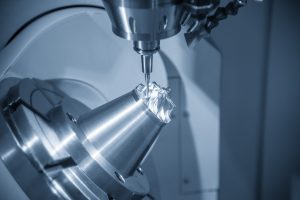What You Need to Know About 3-Axis and 5-Axis CNC Machining
May 03, 2022 CNC machining uses a computer-aided machine to create parts for a range of different industries, from automotive to medical and aerospace. An engineer programs these machines to cut away at a piece of material with a tool to shape it into the desired part.
CNC machining uses a computer-aided machine to create parts for a range of different industries, from automotive to medical and aerospace. An engineer programs these machines to cut away at a piece of material with a tool to shape it into the desired part.
When it comes to CNC machining, two common machines are used: 3-axis and 5-axis. Essentially, a 3-axis CNC machine allows the spindle (which holds the tool) to operate on three axes to cut the workpiece vertically, horizontally, and up and down (X, Y, Z). This method is better for cutting planar (flat) parts.
A 4-axis machine works on three axes, like in 3-axis machining, but also has an A-axis caused by the rotation of the workpiece. And a 5-axis machine works on five axes, adding another element of rotation for more accurate and versatile three-dimensional component creation. Let’s explore how 3- and 5-axis machines function.
3-Axis CNC Machining
As its name implies, a 3-axis CNC machine cuts material on three axes: X, Y, and Z. That is, left-to-right, front-to-back, and up-and-down. They’re easy to program and can easily cut simple parts.
3-Axis CNC Milling
With a 3-axis CNC milling machine, the material is fixed, and a rotating drill or other cutting tools are connected to a spindle that moves along the X, Y, and Z axes to create the desired part. This option is excellent for most simple components.
3-Axis CNC Turning
This method has a piece of material attached to a rotating spindle that is formed into the required shape by a lathe. When the spindle rotates, a center drill traces the perimeter of the part and creates holes along the center axis. This option is faster and can be better for producing a high volume of parts.
However, for more complex parts, 5-axis machines may be preferable. As 3-axis CNC machines only cut along three axes, they are limited in their ability to create non-conventional shapes. Workers might have to go into the machine to physically adjust the workpiece to reach deeper areas or allow the machine to cut at a different angle. This method introduces the potential for human error and risks creating a defective product. It can also raise labor costs.
5-Axis CNC Machining
A 5-axis CNC machine operates on both X, Y, and Z axes in addition to the A and B axes. The A and B axes rotate around the tool, which lets the operator work around the part from all sides and angles. This means they do not have to reposition the part in the machine by hand, speeding up the process significantly.
These machines offer rapid production times and are highly precise, making them excellent for the aerospace and medical industries. There are different types of 5-axis CNC machines, including:
Continuous 5-Axis CNC Machines
With continuous 5-axis CNC machining, both the workpiece and the cutting tool can move and rotate during the process. The tool stays in constant contact with the workpiece, allowing for advanced contouring and intricate component creation. This method is highly efficient and enables the fabrication of sophisticated parts with speed and dimension. However, it is more expensive to manufacture components this way, though it may be necessary for certain industries that regularly manufacture complex parts.
Indexed 5-Axis CNC Machines
With this kind of machining, the cutting tool moves along three axes while the tool head and machining table swivel in two directions. The cutting tool doesn’t maintain continuous contact (as it would with a continuous 5-axis CNC machine), but the automatic swivel makes it more efficient than a 3-axis CNC machine.
Mill-Turning CNC Centers
This type of machining is extremely precise and versatile. It combines the CNC lathe approach with milling tools; it’s essentially a CNC turning machine with milling equipment. The material is placed on a spindle that can rotate (or remain fixed) while the cutting tool creates the part from the piece.
Any of these options can be a great solution depending on the components that need to be created. For simpler parts that don’t need to be rotated, 3-axis CNC machines can be an excellent affordable option; for precision parts, 5-axis CNC machining is probably necessary. For more information about 3-axis and 5-axis CNC machining, visit our affiliates.
Investing in High-Quality Precision CNC Machining
Demmer Manufacturing supports our portfolio companies’ growth by investing in their technology, infrastructure, and people. You can go to our portfolio page to read more about our family of affiliates.

